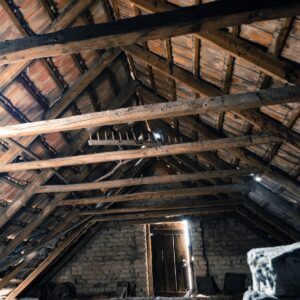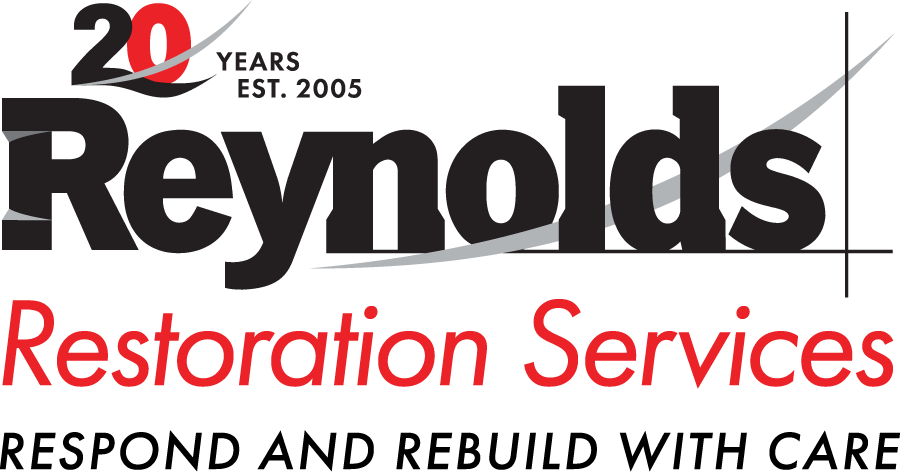
The problem? Ventilation issues are easy to ignore until something’s obviously wrong. By the time you spot mold in the rafters, curled shingles, or ice dams in the winter, serious damage may already have been building for years.
This guide covers what causes poor attic ventilation, the red flags to watch for, how it can impact your home (and budget), steps to improve airflow, and how Reynolds Restoration Services can help if damage has already occurred.
What Causes Poor Attic Ventilation?
A healthy attic relies on balanced airflow: fresh air in through intake vents and stale air out via exhaust vents. When this balance is off, heat and moisture levels rise fast.
Common causes of poor attic ventilation:
- Blocked or insufficient soffit vents: These vents are the main entry point for fresh air. Over time, they can get clogged with dust, dirt, paint, or even bird and insect nests. In some homes, there just aren’t enough vents to begin with. Either way, air circulation suffers.
- Missing ridge or gable vents: Without a way for hot, moist air to escape, it gets trapped, driving up attic temperatures and humidity, which can increase the potential for roof deterioration.
- Improper ventilation installation: Even with vents in place, poor placement or too few vents can leave “dead zones” where heat and moisture linger.
- Insulation covering vent: Insulation that’s shifted or was poorly installed can block soffit vents completely, trapping air and hurting both ventilation and energy efficiency.
- Outdated or nonexistent systems: Many older homes predate modern ventilation standards, relying on minimal or no dedicated airflow. This leaves them more vulnerable to heat and moisture damage.
How Poor Ventilation Impacts Your Home
The damage from poor attic ventilation is often hidden until repairs become expensive. Spotting issues early keeps costs down.
Signs to watch for:
- Overheating in upper floors: Rooms below the attic that are sweltering in summer often mean trapped attic heat radiating downward.
- Ice dams in winter: Warm attic air melts roof snow, which refreezes at the eaves, forcing water back under shingles and into your home.
- High utility bills: Extreme attic temps make your HVAC system work overtime, driving up energy costs.
- Mold or mildew in the attic: Excess moisture feeds mold, which can quickly spread to structural wood and insulation. Learn more about mold remediation services.
- Condensation on nails or insulation: Frosty nails in winter or damp insulation are telltale signs of trapped humidity.
- Roof or shingle damage: Heat buildup can cause shingles to blister, curl, or crack well before their time.
Long-term risks:
| Risk | Impact |
|---|---|
| Mold growth & wood rot | Weakens rafters and sheathing |
| Accelerated roof wear | Shortens roof lifespan, leading to costly replacements |
| Structural compromise | Warped beams, weakened structure |
| Poor indoor air quality | Circulating mold spores, musty odors |
| Higher energy costs | Overworked HVAC, inflated utility bills |
Improving Attic Ventilation
If your attic isn’t “breathing” properly, the steps below can help restore airflow and prevent damage.
Homeowner tips:
- Check for both intake and exhaust vents: Look for soffit vents for intake and ridge/gable vents for exhaust.
- Keep existing vents clear: Remove debris, insulation, paint, or nests blocking airflow.
- Add more vents if needed: Installing extra ridge or gable vents improves exhaust capacity.
- Use vent baffles to keep insulation from blocking soffit vents.
- Consider attic fans or dehumidifiers: Especially helpful in humid climates to control moisture.
- Schedule professional inspections: Experts can identify hidden issues and engineer solutions—before damage spreads.
When to Call Reynolds Restoration Services
Poor attic ventilation is often discovered only after the damage is visible. You’ll notice mold spreading across rafters, water stains on the ceiling, or wood weakened by rot. That’s when you need a team that can handle both the symptoms and the source of the problem.
With over 20 years of experience, we know how to identify ventilation-related issues quickly, repair the damage thoroughly, and ensure the problem doesn’t return. We offer:
- Moisture and mold assessments – We pinpoint exactly where moisture is coming from, determine the extent of mold growth, and map out a plan to stop it from spreading.
- Water damage restoration – Our team removes trapped moisture, repairs or replaces damaged materials, and restores your attic to a safe, dry state.
- Drying and dehumidification – Industrial-grade equipment reduces humidity levels and prevents future mold growth or structural weakening.
- Structural repairs – From replacing rotted sheathing to reinforcing compromised rafters, we restore the strength and stability of your attic.
Your attic ventilation system is one of your home’s first defenses against trapped heat, moisture damage, and rising energy bills. If you’ve noticed warning signs or already have damage from leaks, mold, or wood rot, call Reynolds Restoration Services today. We’ll inspect your attic, identify the root cause, and restore your home’s comfort, safety, and efficiency.

President of Reynolds Restoration Services. Over 20 years of experience in the emergency restoration industry.

